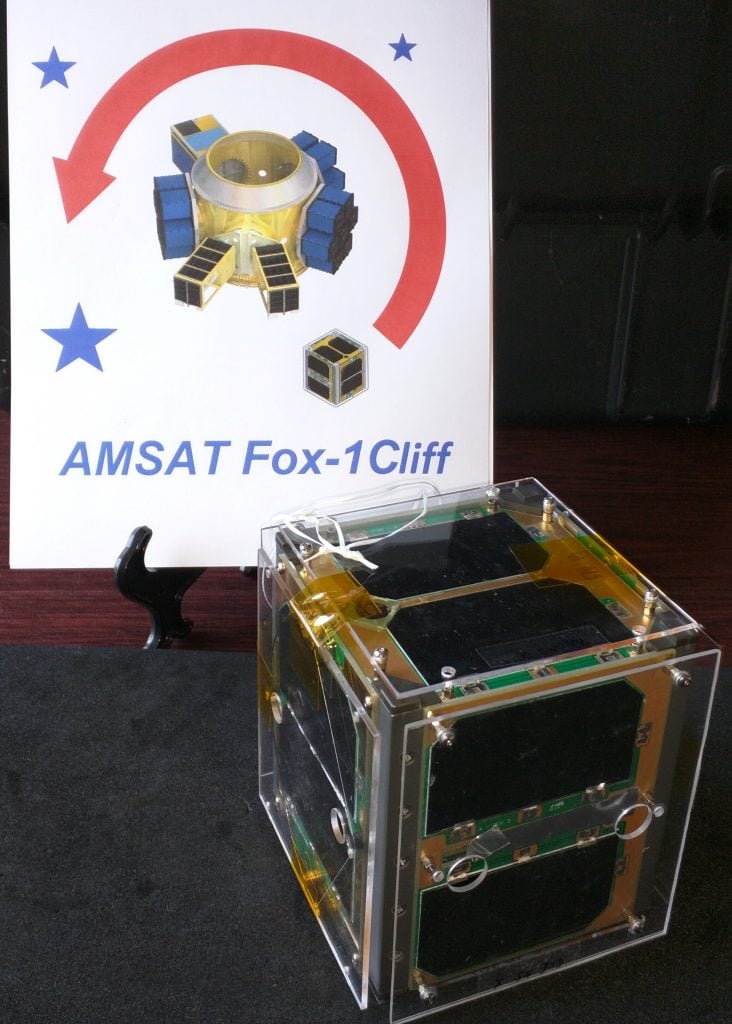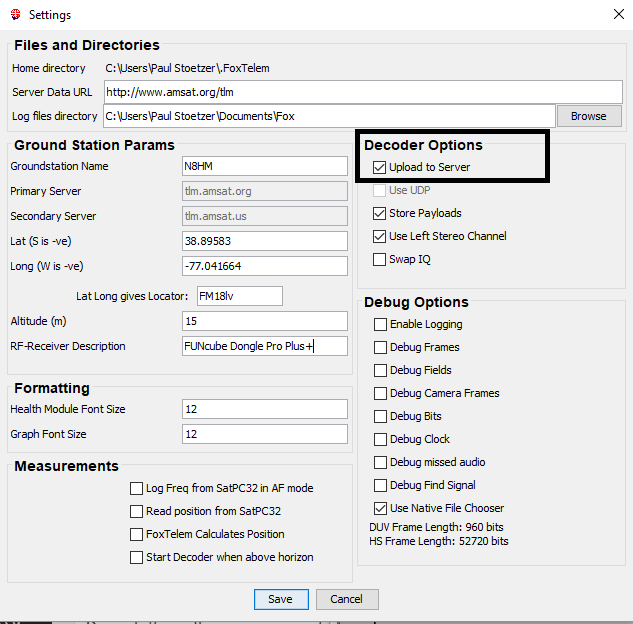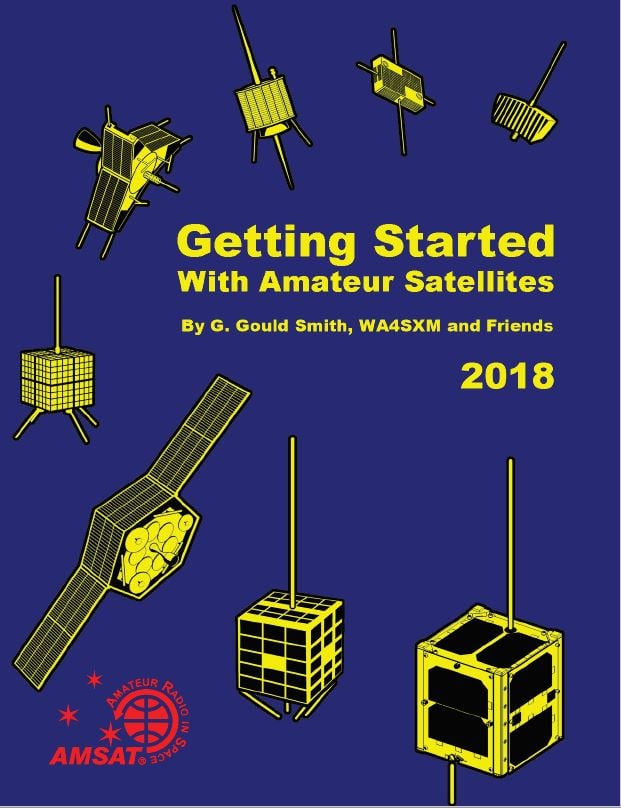
Fox-1Cliff Launch Scheduled for 28-Nov-2018 at 18:32 UTC


Following the successful launch and deployment of Fox-1Cliff, all amateur radio satellite enthusiasts can play an important part in the commissioning of the new satellite. Telemetry helps us tremendously, starting ASAP after startup (~59 minutes after deployment*) and for the next 72-96 hours at least (for the life of the satellite is preferred!) as we look for successful startup, watch the general health and function as the satellite begins to acclimate to space, and start to perform the on orbit checkout. The first station to successfully receive and submit telemetry to the AMSAT server will receive a special 3D printed QSL card acknowledging their contribution.
If you are capturing telemetry with FoxTelem, please be sure that “Upload to Server” is checked in your settings and your Ground Station Params are filled in as well. You can help AMSAT and everyone waiting to get on the air with Fox-1Cliff tremendously, by capturing Fox-1Cliff telemetry.

In the initial Safe Mode after startup, which we actually call Beacon Mode, the transmitter is limited to 10 seconds on time then does the two minutes off cycle. For those of you capturing telemetry, that means that you will only see Current frames and no High or Low frames because the High and Low are truncated as it takes just over 10 seconds to send two frames. You will hear Veronica announcing “Fox-1Cliff Safe Mode” while in Beacon Mode.
We will likely leave the satellite in Beacon Mode for 24 hours to observe power telemetry. If we are seeing good readings from what you gather, when it comes over the U.S. for the first good pass after that holding period we will command it from Beacon Mode to normal Safe Mode. That puts Fox-1Cliff in full (still Safe Mode though) operation and transmits a full two frames of telemetry which is one Current frame followed by, and alternating each ID cycle, a High or a Low frame.
We will begin the rest of the in orbit checklist activities at that time, and it is expected to take 7 to 10 days given the Thanksgiving holiday.
Help your friends and all of our satellite ham friends get on the air and have fun sooner by being polite and patient!
The in orbit checkout procedure is similar to Fox-1D and could be completed in as little as 7 days if we have the cooperation of the users. It is very important, not to mention just plain good Amateur Operating Practice, to refrain from using the transponder uplink so we can do the on orbit tests, including when we turn on transponder mode for testing. I cannot stress enough, the importance of this cooperation not just for us but also for all users, simply having a little patience so we can conduct the tests as quickly and accurately as possible.
AMSAT will make it broadly known when the tests are complete and the transponder is available for all to use. If you hear someone on the transponder, please do not assume that it is open for general use – check our website, Facebook, Twitter, to be sure you are not accidentally jumping in with and unwittingly causing interference as well.
Many hams put thousands of volunteer hours of their time into making Fox-1Cliff happen. Just like any ham radio project you might undertake, we build satellites. We do it because we like to, and when we are done, we freely share our project with hams everywhere as is the spirit of amateur radio. I have to say though, that the incidents we have experienced in the past with stations intentionally disregarding the command stations requests to keep the frequency clear during testing not only delays the commissioning, but also negatively impacts the enthusiasm that our volunteers feel toward handing over a new bird to the members and users as soon as possible.
I am asking all satellite hams to contribute just a little bit of your time to the fun now, by being patient and just gathering telemetry, not using the transponder uplink, and helping us complete the last few days of getting Fox-1Cliff in orbit and operating for all of you.
Thank you very much, see you on the bird!
Jerry Buxton, N0JY
(AMSAT VP Engineering)
*Time of deployment will be made generally available through AMSAT as soon as Spaceflight provides the information to us.

The next AMSAT Fox-1 satellite, Fox-1Cliff, is scheduled to launch on Spaceflight’s SSO-A mission on a SpaceX Falcon 9 from Vandenberg Air Force Base.
Fox-1Cliff carries the Fox-1 U/v FM repeater as well as AMSAT’s L-Band Downshifter.
Uplink: 435.300 MHz FM voice (67.0 Hz CTCSS tone) / 1267.300 MHz FM voice (67.0 Hz CTCSS tone)
Downlink: 145.920 MHz FM voice; AFSK digital data up to 9600 bps
Transmit power: 600 mW nominal
As part of the preparations for the launch of Fox-1Cliff, AMSAT is making the “Getting Started With Amateur Satellites” book available for a limited time as a download with any paid new or renewal membership purchased via the AMSAT Store. This offer is only available with purchases completed online, and for only a limited time. A perennial favorite, Getting Started is updated every year with the latest amateur satellite information, and is the premier primer of satellite operation. The 186 page book is presented in PDF format, in full color, and covers all aspects of making your first contacts on a ham radio satellite.

Please take advantage of this offer today by visiting the AMSAT store at https://www.amsat.org/shop/ and selecting any membership option. While there, check out AMSAT’s other items, including the M2 LEOpack antenna system, Arrow antennas, AMSAT shirts, and other swag. Be sure to view your cart before going to checkout. If you add a membership and then go directly to checkout, you’ll never see an option to add your free gift.
Fox-1Cliff carries the flight spare of the AO-85 Vanderbilt University Low Energy Proton (LEP) radiation experiment, and the standard Fox-1 Penn State University–Erie gyroscope experiment. Virginia Tech provided a VGA camera which is the same as AO-92 but will provide images at a higher 640 x 480 resolution. These non-SSTV images will be decoded in the FoxTelem software.
Fox-1Cliff, unlike the other three Fox-1 FM spacecraft, does not have an active AFC (Automatic Frequency Control) on the uplinks.
Fox-1Cliff’s Data Under Voice (low-speed telemetry) will be the same as for AO-85, AO-91, and AO-92. It will be supported by the same FoxTelem software already released.
As with AO-92, a high-speed mode will be used to support the Virginia Tech VGA camera experiment. This mode will be active for 40 minutes by ground command before reverting to standard U/v repeater voice operation.
Fox-1Cliff is named in honor of long-time AMSAT member, contributor, and benefactor Cliff Buttschardt, K7RR (SK), who passed away in 2006. Cliff’s contributions to AMSAT and other amateur satellite programs, including serving as an adviser during the initial development of the CubeSat specification at California Polytechnic State University, earned him the Lifetime Achievement Award from Project OSCAR in 2006.

AMSAT Vice-President Engineering Jerry Buxton, N0JY, has posted a YouTube video entitled “Fox-1Cliff Delivery And Integration” in which he explains what goes on in the final step of getting an amateur radio CubeSat into orbit.